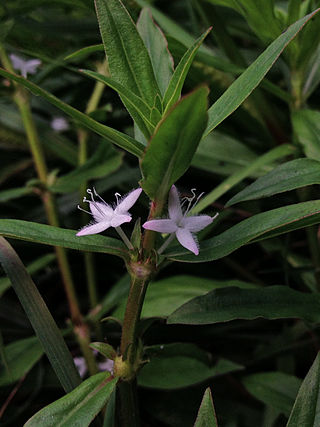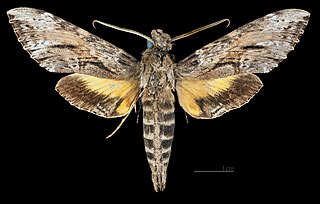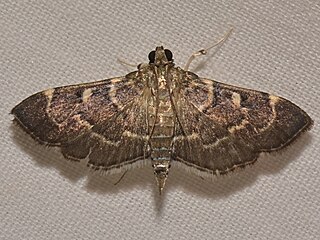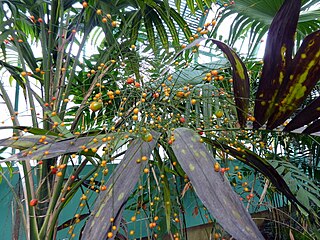
The Puerto Rico national basketball team represents Puerto Rico in men's international basketball competitions, it is governed by the Puerto Rican Basketball Federation, The team represents both FIBA and FIBA Americas.

Diodia is a genus of flowering plants in the family Rubiaceae. It was described by Carl Linnaeus in 1753. The genus is found from southern and eastern United States, South America, Central America, Mexico, the West Indies and tropical Africa.

The currencies of Puerto Rico closely follow the historic development of the territory. As a Province of Spain and a territory of the United States, Puerto Rico was granted the use of both foreign and provincial currencies. Following the Spanish colonization in 1508, Puerto Rico became an important port, with its own supply of gold. However, as the mineral reserves ran empty within the century, the archipelago's economy suffered. The Spanish Crown issued the Situado Mexicano, which meant that a semi-regular shipment of gold from the Viceroyalty of New Spain would be sent to the island, as a way to provide economic support. Between 1636 and 1637, Philip IV of Spain imposed a tax which had to be paid using a revenue stamp. Inspired by this, Puerto Rico began producing banknotes in 1766, becoming the first Overseas Province to print 8-real banknotes in the Spanish Empire and which in the Spanish government's approval of subsequent issues.

Isognathus rimosa, the rimosus sphinx, is a moth of the family Sphingidae. The species was first described by Augustus Radcliffe Grote in 1865.

Coccothrinax is a genus of palms in the family Arecaceae. There are more than 50 species described in the genus, plus many synonyms and subspecies. A new species was described as recently as 2017. Many Coccothrinax produce thatch. In Spanish-speaking countries, guano is a common name applied to Coccothrinax palms. The species are native throughout the Caribbean, the Bahamas, extreme southern Florida and southeastern Mexico, but most of the species are known only from Cuba.

Calyptronoma is a genus in the palm family, native to the Greater Antilles. They have pinnately compound leaves with short petioles. The name was coined by August Grisebach who first described the genus in his 1846 Flora of the British West Indian Islands.

Gaussia attenuata is a palm which is native to Puerto Rico. The species grows on steep-sided limestone hills in Puerto Rico.

Roystonea regia, commonly known as the royal palm, Cuban royal palm, or Florida royal palm, is a species of palm native to Mexico, the Caribbean, Florida, and parts of Central America. A large and attractive palm, it has been planted throughout the tropics and subtropics as an ornamental tree. Although it is sometimes called R. elata, the conserved name R. regia is now the correct name for the species. The royal palm reaches heights from 15–24 m (50–80 ft) tall. Populations in Cuba and Florida were long seen as separate species, but are now considered a single species.

Roystonea borinquena, commonly called the Puerto Rico royal palm, is a species of palm which is native to Hispaniola, Puerto Rico and the Virgin Islands.

Cryptobotys is a genus of moths in the family Crambidae described by Eugene G. Munroe in 1956. It is monotypic, with its only species, Cryptobotys zoilusalis, described by Francis Walker in 1859. It is found in Cuba, Jamaica, Puerto Rico, Central America and the southern United States, where it has been recorded from Florida.

Leucothrinax morrisii, the Key thatch palm, is a small palm which is native to the Greater Antilles, northern Lesser Antilles, The Bahamas and Florida and the Florida Keys in the United States.
Portentomorpha is a genus of moths of the family Crambidae. It contains only one species, Portentomorpha xanthialis, which is found from Texas to Louisiana and Florida, the West Indies and from Mexico to Bolivia.

Lasiacis (smallcane) is a genus of Neotropical plants in the grass family, found in the Americas from Mexico and Florida south to Argentina.

Eryngium foetidum is a tropical perennial herb in the family Apiaceae. Common names include culantro (Panama), cimarrón,recao, chardon béni (France), Mexican coriander, samat, bandhaniya, long coriander, Burmese coriander, sawtooth coriander, Shadow Beni (Caribbean), and ngò gai (Vietnam). It is native to Mexico, the Caribbean, and Central and South America, but is cultivated worldwide, mostly in the tropics as a perennial, but sometimes in temperate climates as an annual.

Taíno is a term referring to a historic Indigenous people of the Caribbean, whose culture has been continued today by their descendants and Taíno revivalist communities. Indigenous people in the Greater Antilles did not refer to themselves as Taínos, as the term was coined by the anthropologist Constantine Samuel Rafinesque in 1836. The Indigenous peoples of the Greater Antilles are sometimes referred to as Island Arawaks. At the time of European contact in the late 15th century, they were the principal inhabitants of most of what is now Cuba, the Dominican Republic, Jamaica, Haiti, Puerto Rico, the Bahamas, and the northern Lesser Antilles. The Lucayan branch of the Taíno were the first New World peoples encountered by Christopher Columbus, in the Bahama Archipelago on October 12, 1492. The Taíno historically spoke an Arawakan language. Granberry and Vescelius (2004) recognized two varieties of the Taino language, "Classical Taino", spoken in Puerto Rico and most of Hispaniola, and "Ciboney Taino", spoken in the Bahamas, most of Cuba, western Hispaniola, and Jamaica. They lived in agricultural societies ruled by caciques with fixed settlements and a matrilineal system of kinship and inheritance. Taíno religion centered on the worship of zemis.
Eutelia furcata, the Florida eutelia moth, is a moth of the family Noctuidae. The species was first described by Francis Walker in 1865. It is found from the southern United States to Mexico, Cuba, Puerto Rico and Central America.

Crusea is a genus of angiosperms in the family Rubiaceae. The genus is found in the south-western United States, Mexico, and Central America. A few species are naturalized in Cuba and Puerto Rico.

Prestoea acuminata var. montana is a perennial palm in the family Arecaceae.

Chamaedoreeae is a palm tribe in the subfamily Arecoideae. It has five genera.


















